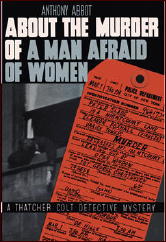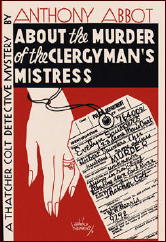Sat 31 May 2014
A Review by Marvin Lachman: ANTHONY ABBOT – About the Murder of a Man Afraid of Women.
Posted by Steve under Authors , Reviews[6] Comments
ANTHONY ABBOT – About the Murder of a Man Afraid of Women. Farrar & Rinehart, hardcover, 1937. No paperback edition.
A writer who was once tremendously popular, Anthony Abbot, is no longer read today. That is unfortunate because a recent reading (or in some cases rereading) of his books, published between 1930 and 1943, shows them to be still quite readable. In addition to a nostalgic look at New York in the past, there are plots far more imaginative than many conceived today.
The general caliber of writing is not good, but there are some touches that are surprisingly effective. For example, in the book reviewed below, Abbot describes a police lab, drawing an analogy to the medieval attempts to turn baser metals into gold. “Here, instead, men sought to turn human flesh and blood into grand jury indictments.â€
Abbot, the pseudonym of Fulton Oursler, author of the best seller The Greatest Story Ever Told, is usually lumped with another pseudonymous writer, his contemporary, S. S. Van Dine. There are definite similarities, although Oursler eschewed the erudition and footnotes which caused Ogden Nash to threaten to kick Van Dine’s creation [Philo Vance in the pants]. Abbot’s Thatcher Colt, like Philo Vance, is larger than life, but he is easier to take. Both authors have “Watsons†whose names are the author’s pseudonyms and who record the adventures of their employers. Each series has a somewhat dense District Attorney.
Another similarity is the use of real murder cases for many of the novels. There was a time when mystery novelists like Van Dine, Patrick Quentin, Anthony Boucher, John Dickson arr, and Abbot were very knowledgeable about the great true crimes of the past. In the first Thatcher Colt book, Abbot has the detective, who owns a library of 15,000 true crime books, ask, Ãf our criminals plagiarize from the past, why not our detectives?
Much has been written about Abbot’s second mystery, About the Murder of the Clergyman’s Mistress (1932) and its basis in the Hall-Mills case of 1922. I do not recall anyone pointing out that a lesser-known Abbot, About the Murder of a Man Afraid of Women (1937) is based on the William Desmond Taylor case, subject of two recent popular nonfiction books, though it clearly is.
Man Afraid of Women has Thatcher Colt due to get married in a few days and frustrated by such problems as auto deaths, lack of adequate gun control, and pervasiveness of drugs in New York City. There is also a reference to air pollution. (Sound familiar?) Of historical interest is the attitude of the characters toward blacks, an outrageous racism as prevalent as the anti-Semitism found in British novels of the period between the wars.
Colt’s fiancee sends him the problem of a secretary with a missing boyfriend, and that soon leads to the titular murder victim. The puzzle is a difficult one, and while the solution is not totally satisfactory, there is some real misdirection along the way and an exciting, albeit melodramatic, ending.
Sometimes the writing is overheated, as when Abbot refers to this case as “the greatest of crime problems.” It’s not, but it’s a good puzzle nonetheless.
Besides plot surprises, there is some dialogue that we would not expect. Coitus interruptus in a mystery written in the 1930s! Colt’s “Watson,”Anthony Abbot, is upset by Colt’s impending marriage and retirement. He asks his wife, Betty, “Why had a woman come back into the life of the greatest detective of all time?” Abbot’s wife claims he is jealous and sits on his knee. We read, “I spanked her and took her to bed. And then came one of life’s embarrassing moments, for shortly thereafter the telephone rang. Thatcher Colt was at the other end of the wire.”
Vol. 13, No. 2, Spring 1991.
NOTE: For Mike Nevins’ review of About the Murder of the Clergyman’s Mistress earlier on this blog, go here.



June 2nd, 2014 at 10:48 am
This, I think, is my favorite of the Thatcher Colt books. Though it drags a bit in the middle section with lots of Q&A in the narrative, it picks up after the second murder. Unlike Marvin I thought the ending was perfectly suited to the story with a couple of good surprises too. I’m surprised these books have NEVER been reprinted since the late 40s. They are excellent examples of early police procedurals and, as Marvin points out, are unexpectedly modern in some of the details.
June 2nd, 2014 at 7:15 pm
You’re absolutely right about none of the Colt books being reprinted in over 70 years, John. I’d have to assume he was reasonably popular in his day — there having been either six or eight of them (the last two reportedly ghost written by Oscar Schisgall) — but Abbot is really a forgotten mystery writer today.
June 3rd, 2014 at 8:32 pm
About the Murder of a Startled Lady is available in e-book form, but it is odd Colt remained so hard to find, especially considering Fulton Oursler was a major writer of the era well into the 1950’s.
I think The Shudders and The Creeps may be the most interesting of the Colt books, though I like this and About the Murder of a Circus Lady as the best of the strictly Van Dine style books.
The Van Dine school even in the twenties and thirties took chances with subject. They tended to follow Van Dine in being more enlightened racially than most (Mike Grost has written a great deal on this) and there are themes that can surprise you in Abbot, early Ellery Queen, and Rex Stout (certainly influenced by Van Dine but not is style) who has lesbians playing a major role in Fer De Lance.
We see them as stuffy, formal, and a bit wooden, but they were sophisticated, grown up, and a breath of fresh air when they were being written. Even today compared to that exemplar of the American detective story, Arthur B. Reeve, you can see where Van Dine and company were a huge leap forward.
June 4th, 2014 at 10:28 am
Funny thing, David. On Monday I received from Dan Stumpf a dvd of the film CIRCUS QUEEN MURDER which I asked Dan to look for at Cinevent over the Memorial day weekend. In the film, Aldolph Manjou plays Colt. I presume it’s the film version of MURDER OF A CIRCUS LADY.
June 4th, 2014 at 6:02 pm
Ray
It is, and notice the fairly enlightened treatment of the African tribesmen in the film (as in the book).
June 4th, 2014 at 7:51 pm
David,
Thank you for the kind comments!
Anthony Abbot is apparently moving into the public domain in Canada. See project Gutenberg Canada:
http://www.gutenberg.ca/
Then do a search on “Oursler” (his real name). Free e-books of “About the Murder of a Startled Lady”.